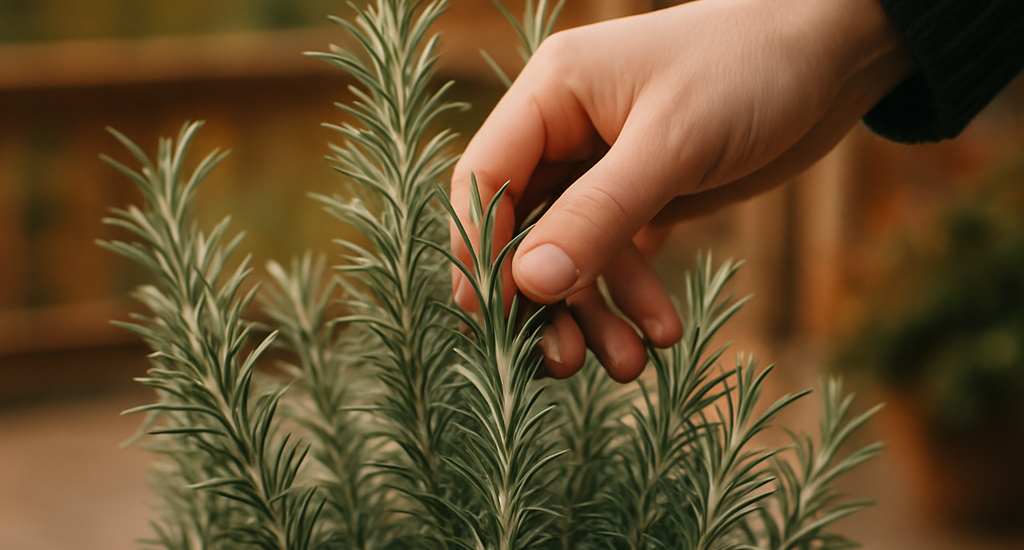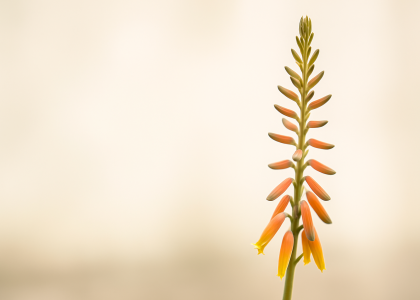Whether you’re just starting out or looking to elevate your herb garden, this guide will walk you through every step of growing rosemary successfully indoors and outdoors, with practical tips and soulful touches.
Quick Rosemary Facts
| Botanical Name | Salvia rosmarinus (formerly Rosmarinus officinalis) |
| Type | Woody perennial herb |
| Height | 2-4 feet (60-120 cm); up to 6 feet in ideal conditions |
| Sunlight | 6-8 hours full sun |
| Watering | Drought-tolerant; water sparingly |
| Best For | Containers, garden beds, raised beds |
| Zones | 7-10 (hardy), 6 and below (bring indoors for winter) |
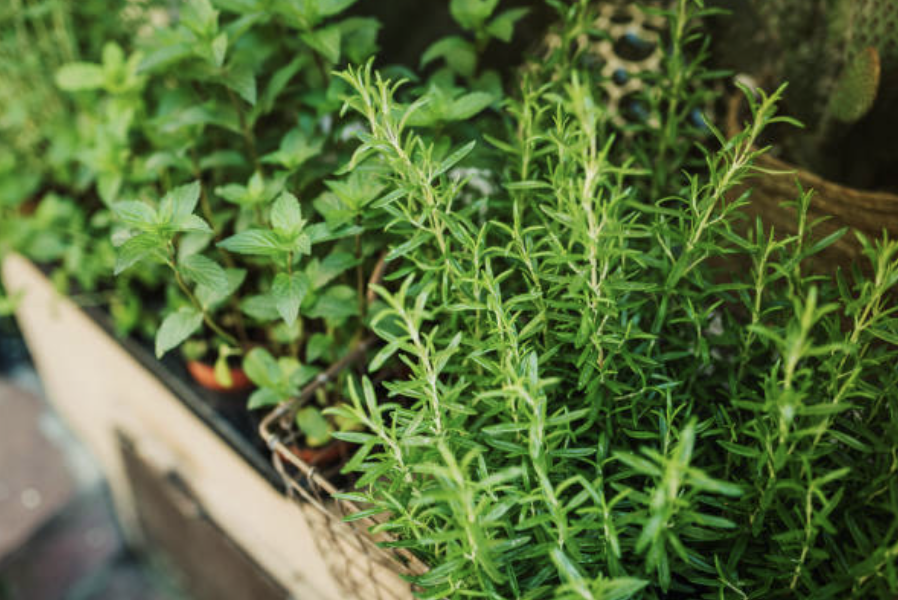
5 Essential Tips for Growing Rosemary Like a Pro
1. Sunlight & Soil: The Foundation of Resilience
Rosemary thrives in the sun, needing 6-8 hours of direct sunlight daily. It originated from the rocky, coastal regions of the Mediterranean, and its love for sandy, well-draining soil reflects its history.
Pro Tip:
- In cooler climates, consider containers or raised beds for better drainage.
- Use a gritty soil mix (equal parts potting soil, sand, and perlite).
Legend has it that rosemary grew along the shores where Aphrodite emerged from the sea, its name meaning "dew of the sea."
2. Watering Wisdom: Embrace the Dry Side
Rosemary’s Mediterranean roots make it a drought-tolerant herb. Overwatering is its greatest enemy.
| Stage | Watering Frequency |
| Seedling | Light watering every few days (keep soil moist) |
| Established | Water when top 2 inches of soil feel dry |
| Hot weather | Weekly watering in summer, if rainfall is scarce |
| Winter indoor | Every 10-14 days, depending on humidity |
Mindful watering: Let rosemary's roots breathe, just as it would on a sun-baked Mediterranean cliff.
3. Pruning & Harvesting: Shape with Care
Pruning rosemary not only keeps it bushy and healthy, but also enhances the flavor of its tender new growth.
- Prune 2-3 inches off the top stems during spring and summer.
- Always cut above a leaf node to encourage branching.
- Avoid cutting into the woody stems—they rarely regrow.
Imagine a cozy winter evening: trimming a sprig of rosemary for your roasted vegetables, letting its aroma fill the kitchen, adding warmth and flavor to the season.
4. Winter Care: Keep Rosemary Thriving Indoors
For zones 6 and below, rosemary needs winter protection.
- Indoor Light: Position near a south-facing window or under a grow light (12-14 hours/day).
- Temperature: Maintain 60-70°F (15-21°C).
- Humidity: Keep at 40-50%. Use a humidity tray or mist occasionally.
Your rosemary plant becomes a living connection to summer’s warmth even in the heart of winter.
5. Companion Planting: Rosemary’s Garden Friends
| Companion | Benefit |
| Cabbage family (brassicas) | Repels cabbage moths |
| Carrots | Deters carrot flies |
| Lavender & Sage | Thrive in similar conditions |
Avoid: Planting near basil or mint (they prefer more moisture).
Let rosemary stand guard over your garden, its scent weaving protection for its leafy companions.
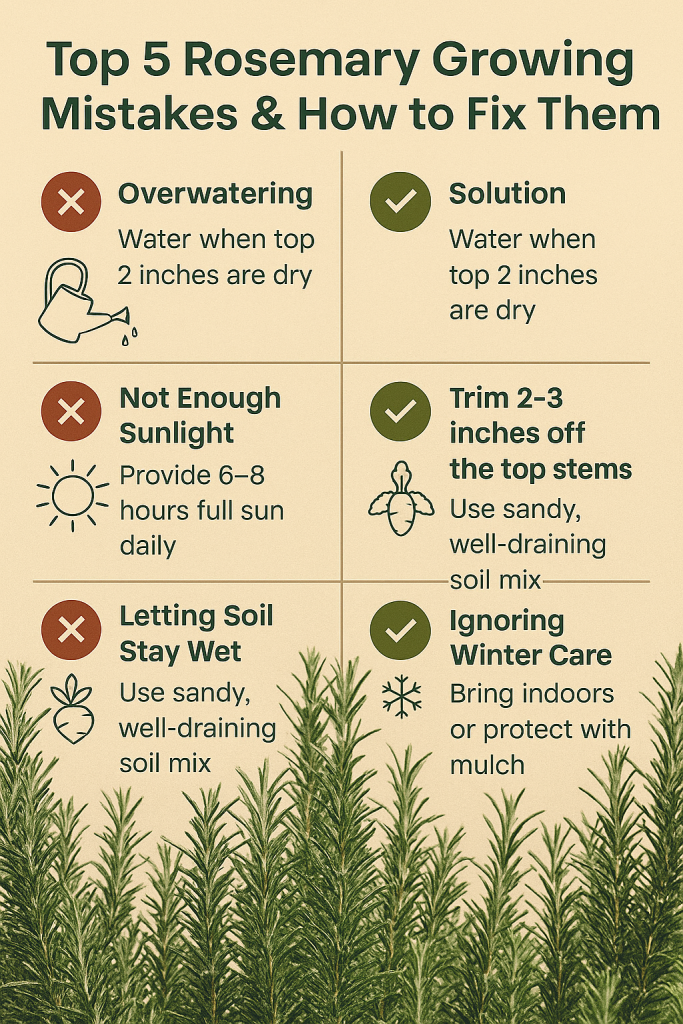
Avoid These Common Rosemary Growing Mistakes
1. Overwatering: A Silent Killer
| Symptom | Cause | Fix |
| Yellowing leaves | Root rot from excess water | Water only when soil is dry |
| Wilting (with moist soil) | Poor drainage | Use sandy, gritty soil mix |
2. Lack of Sunlight: Spindly Growth
| Symptom | Cause | Fix |
| Leggy stems | Not enough sun | Move to full sun location |
| Sparse leaves | Insufficient light | Supplement with grow light indoors |
3. Pests & Diseases: Rare but Real
| Problem | Symptoms | Solution |
| Spider mites | Fine webbing, stippled leaves | Spray with water or neem oil |
| Powdery mildew | White powdery leaf coating | Improve airflow, avoid overhead watering |
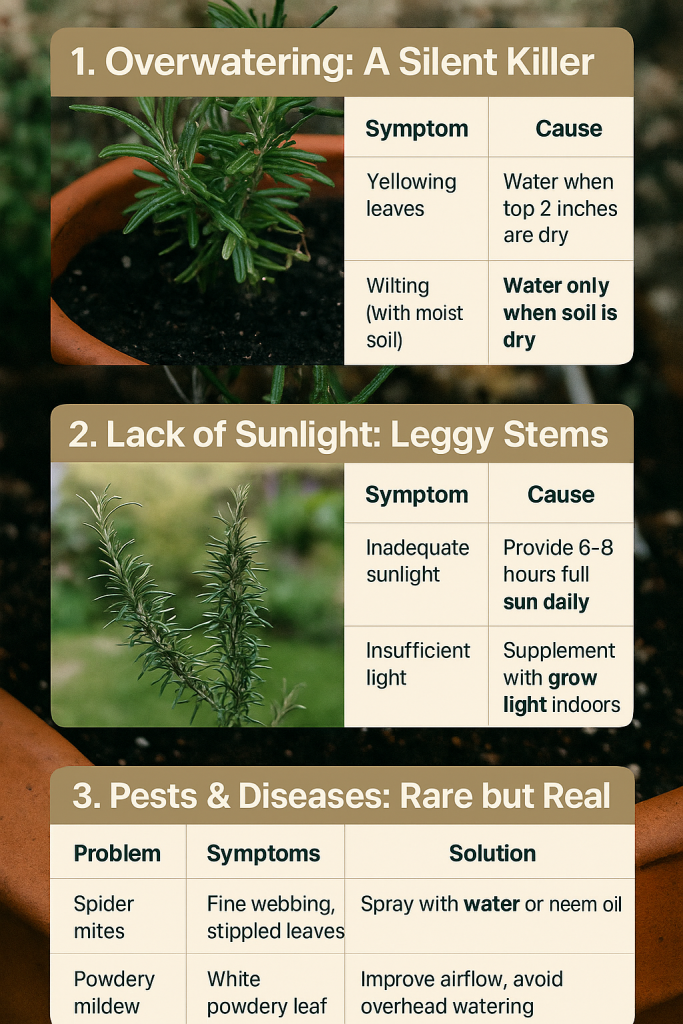
Choosing Your Rosemary Variety: Beauty Meets Function
| Variety | Growth Habit | Cold Hardiness | Best Use |
| Tuscan Blue | Upright, tall | USDA 8-10 | Hedges, structural planting |
| Arp | Spreading, hardy | USDA 6-10 | Cold climates, culinary |
| Prostratus | Trailing, low | USDA 8-10 | Groundcover, hanging pots |
For colder zones, choose ‘Arp’—the hardiest rosemary variety that carries the warmth of the Mediterranean even through frosts.
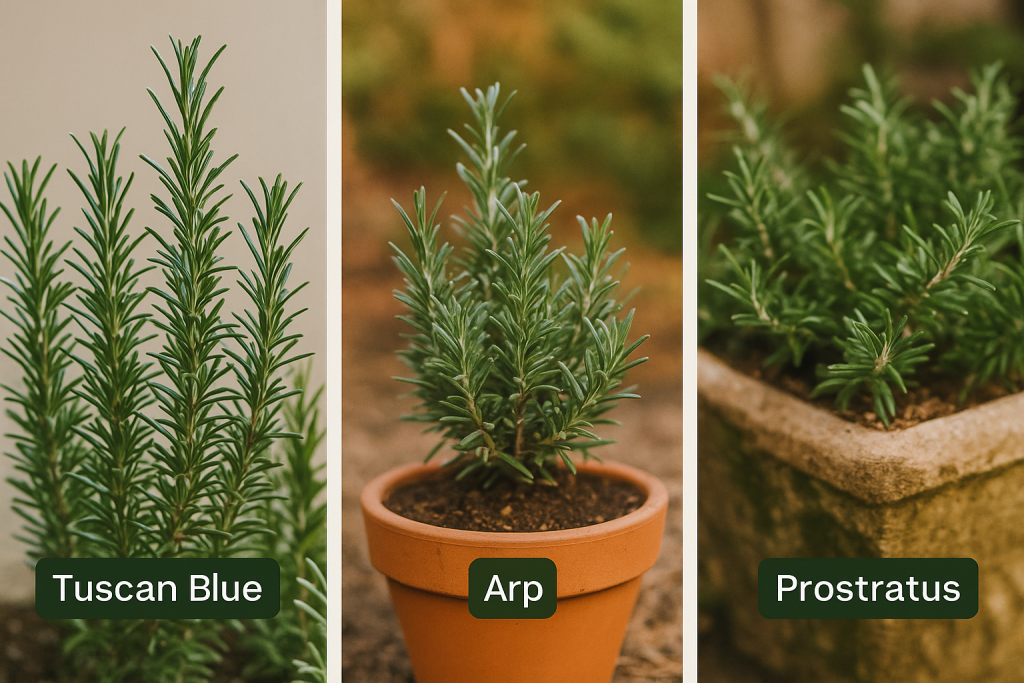
Companion Planting: Rosemary’s Role in a Thriving Garden Ecosystem
Rosemary isn't just a fragrant herb; it's a natural guardian in your garden. Its strong aroma deters pests and supports neighboring plants, making it an excellent companion in various planting schemes.
Rosemary’s Companion Benefits:
| Companion Plant | Benefits |
| Cabbage, Broccoli, Cauliflower (Brassicas) | Rosemary's scent repels cabbage moths and other pests. |
| Carrots | Helps deter carrot flies, enhancing yield and quality. |
| Lavender | Both thrive in similar conditions and attract pollinators. |
| Sage | Shares drought tolerance and pest-repelling properties. |
Plants to Avoid Planting Near Rosemary:
- Mint and Basil: Require more water, which can create overly moist conditions unsuitable for rosemary.
- Cucumbers and Watermelons: Prefer more moisture and can overshadow rosemary, limiting its growth.
Sustainable Gardening: Growing Rosemary the Eco-Friendly Way
Incorporating rosemary into your garden aligns well with sustainable gardening practices. Its low maintenance and pest-repelling qualities reduce the need for chemical interventions.
Eco-Friendly Gardening Practices with Rosemary:
- Water Conservation: Rosemary's drought tolerance makes it ideal for xeriscaping, reducing water usage.
- Pest Management: Its natural oils deter various pests, minimizing the need for pesticides.
- Soil Health: Companion planting with legumes like beans can enhance soil nitrogen levels, benefiting rosemary and neighboring plants.
- Pollinator Support: Rosemary flowers attract bees and other beneficial insects, promoting biodiversity.
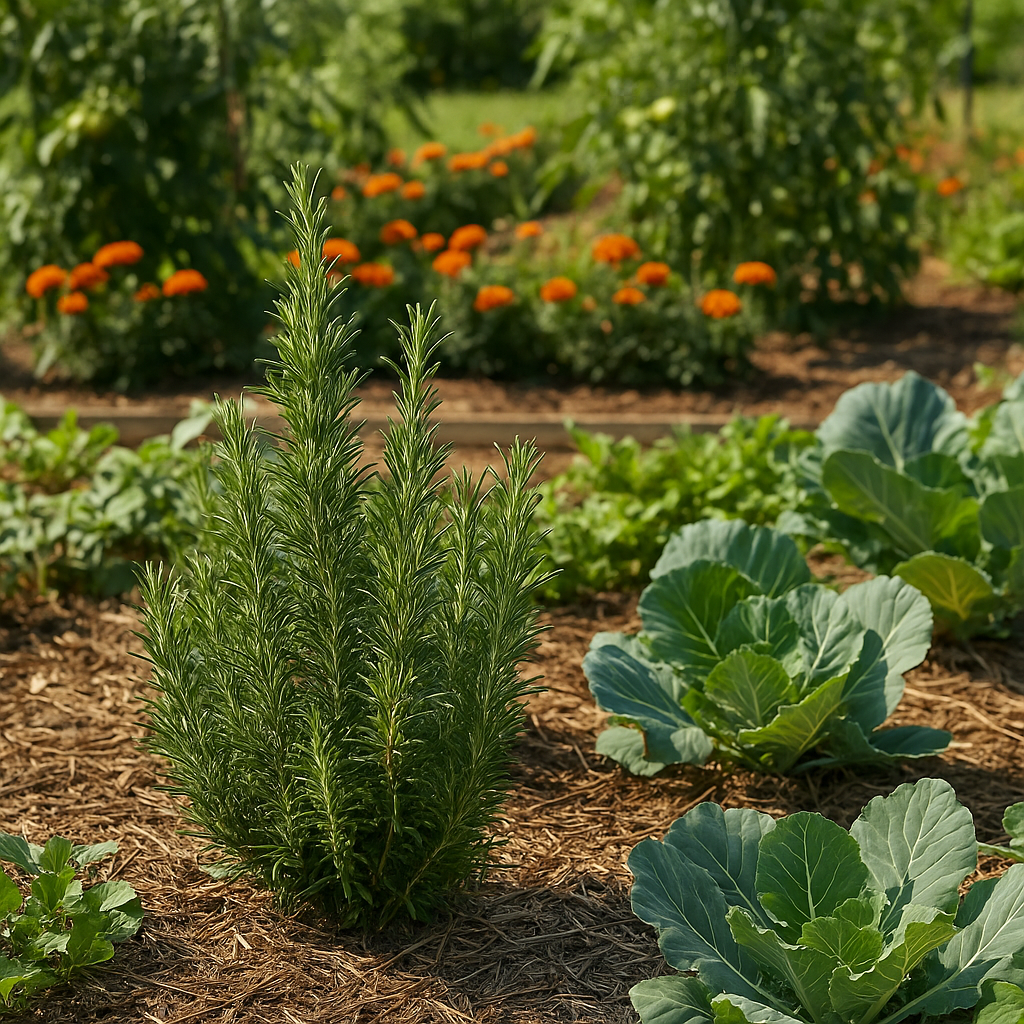
SEO Meta Description:
Master rosemary care indoors and out with this complete guide! Learn pruning tips, winter protection, companion planting strategies, and eco-friendly gardening practices to grow a resilient, pest-repelling herb garden.

